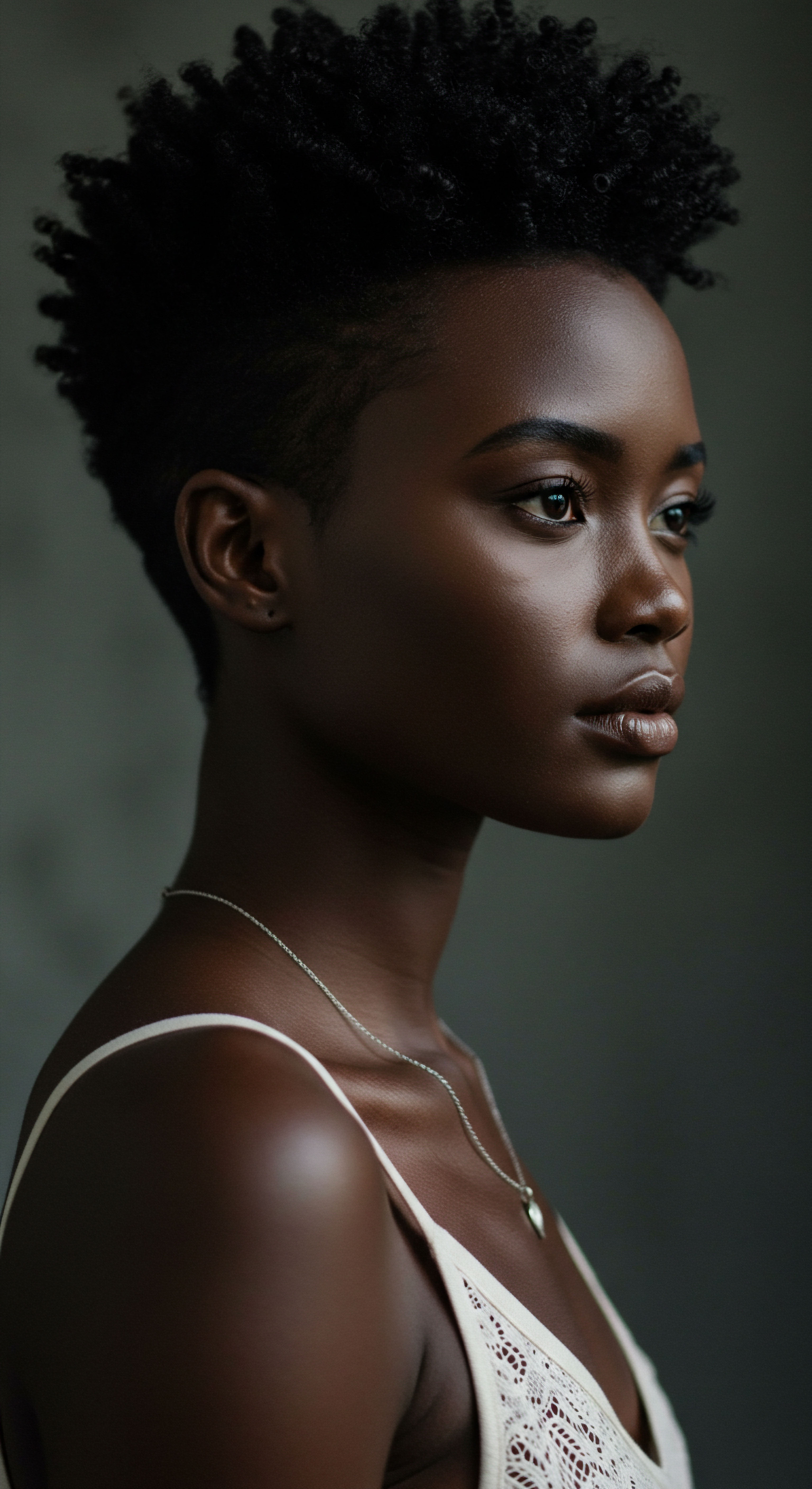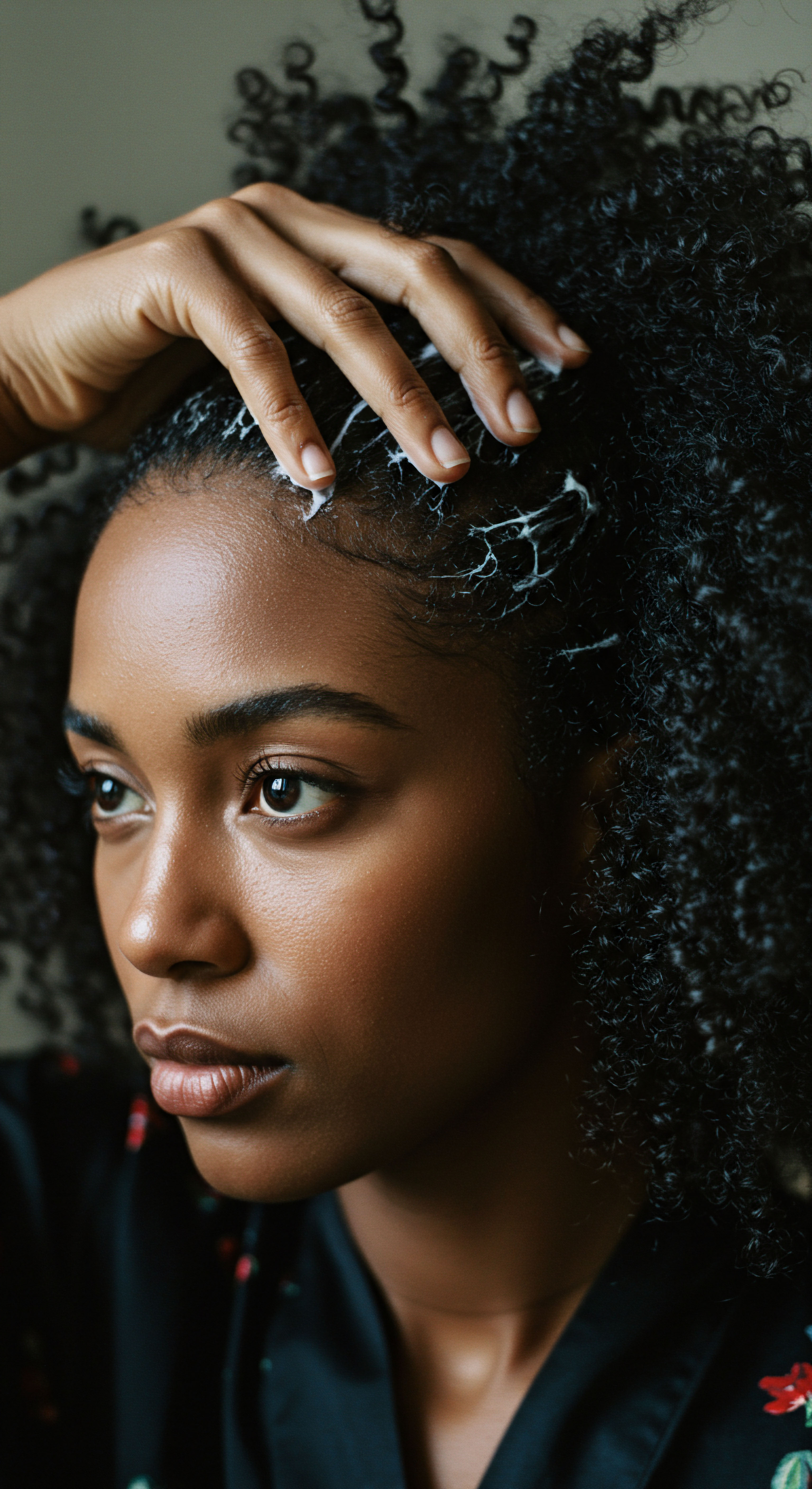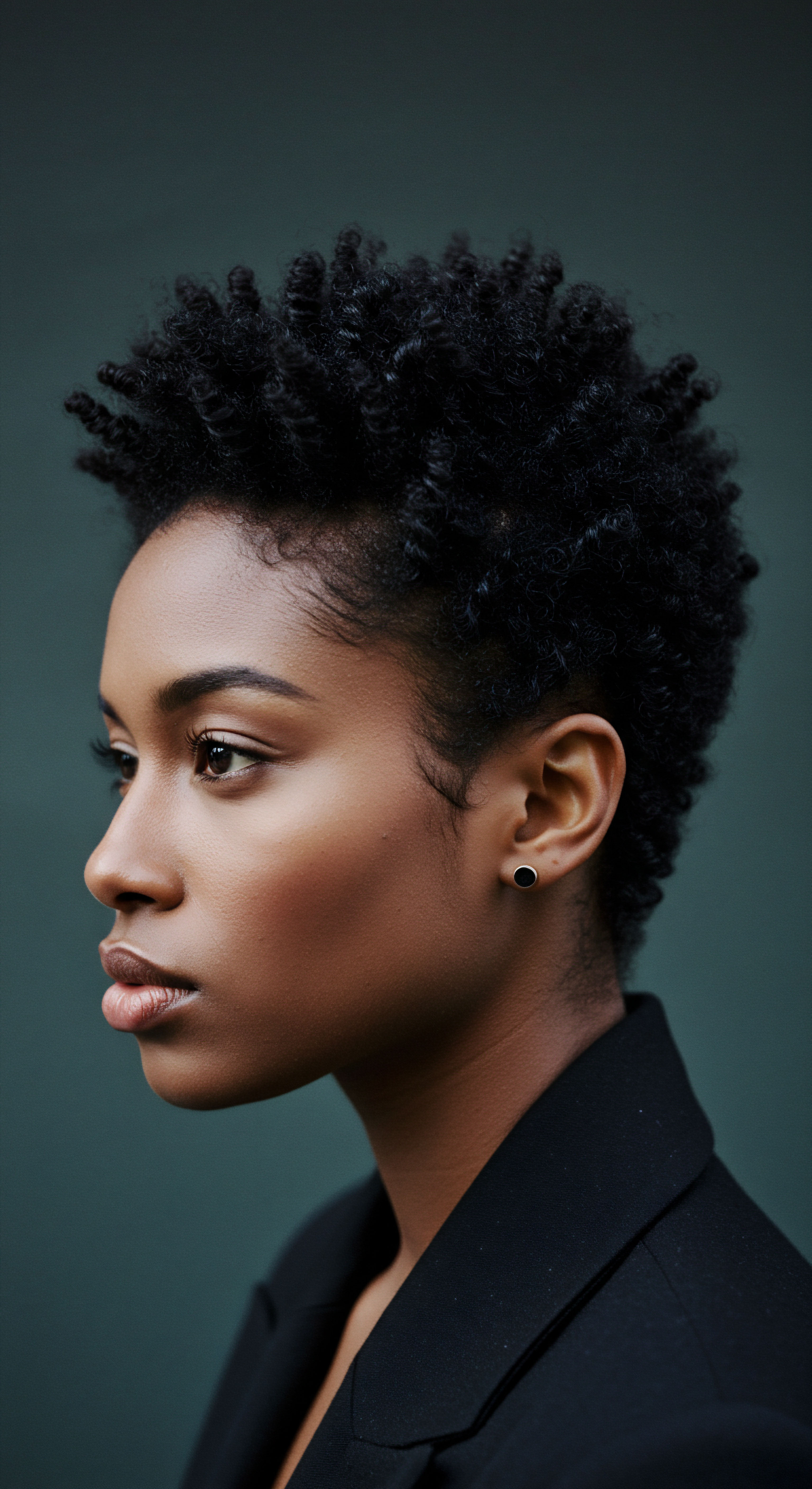
Roots
A quiet understanding often settles upon us when we consider the rhythm of life, the gentle ebb and flow that shapes our days and nights. For our hair, a vibrant expression of self, this nocturnal cadence holds a special significance. It is within these hours of deep repose that profound work unfolds, far from the bustling demands of daylight. We invite you to consider how the quiet of night offers a profound contribution to the strength and luster of each strand, an intimate conversation between rest and radiance that is often overlooked in the hurried pursuit of external remedies.

The Hair Follicle’s Nocturnal Rhythm
Beneath the surface of our scalp, the hair follicles, those miniature organs responsible for producing each individual strand, adhere to their own biological clock. This internal timing system, known as the circadian rhythm, orchestrates a symphony of cellular activities throughout a twenty-four-hour cycle. While we sleep, the body prioritizes restoration and repair, a process that extends directly to the hair follicle.
During the day, hair and skin cells are largely in a protective mode, guarding against environmental stressors like UV radiation and pollutants. Once twilight descends, a shift occurs, and the focus turns inward to recuperation.
This nightly reset is not merely a passive state; it is a period of heightened activity for cellular regeneration. Blood flow to the scalp increases during sleep, ensuring that hair follicles receive a steady supply of oxygen and essential nutrients. This enriched environment supports the active growth phase of hair, known as anagen. A disruption in this delicate cycle can compromise the follicle’s ability to perform its regenerative duties, potentially impacting hair growth and overall health.

Unseen Cellular Repair
The skin, our largest organ, shares a deep connection with hair health, and both undergo significant repair processes while we rest. Studies reveal that skin cell renewal and DNA repair peak during the hours between 11 PM and midnight. This cellular diligence extends to the scalp, where hair follicle cells are actively working to mend damage accrued throughout the day. Growth hormones, released during deep sleep, play a considerable role in this repair work, stimulating collagen production and maintaining skin thickness, which indirectly supports a healthy foundation for hair.
The silent hours of night offer a dedicated sanctuary for hair follicles, enabling profound cellular repair and renewal far from daily stressors.
A significant aspect of this nocturnal repair mechanism involves the reduction of oxidative stress. Our bodies are constantly exposed to free radicals, which can cause cellular damage, including to hair follicles. During sleep, the body’s antioxidant systems are more active, working to neutralize these harmful molecules. Research suggests that oxidative stress can influence hair aging and hair loss, making this nighttime antioxidant activity particularly valuable for maintaining hair vitality.

What is a Circadian Rhythm in Relation to Hair?
The circadian rhythm in relation to hair refers to the natural, approximately 24-hour cycle of biological processes that influence hair follicle activity and growth. This internal clock dictates periods of heightened cellular division, repair, and rest within the hair follicle itself. For instance, the genes that control circadian rhythms, such as Clock and Bmal1, play a part in regulating the hair growth cycle.
Research in mice has indicated that disruptions in these genes can delay the progression of the hair growth phase, particularly the anagen or active growth phase. This suggests that the timing of our sleep and wakefulness is not merely about overall body rest, but also about the precise synchronization of these minute, yet powerful, cellular mechanisms within our hair follicles.
- Anagen Phase ❉ The active growth period for hair, heavily influenced by synchronized cellular activity during restorative sleep.
- Telogen Phase ❉ The resting phase, which can be prolonged by disruptions to the hair follicle’s natural circadian rhythm, potentially leading to increased shedding.
- Melatonin Production ❉ This hormone, primarily known for regulating sleep, also appears to have a direct role in hair growth, with receptors found in dermal papillae cells.

Ritual
As we move from the unseen depths of cellular activity to the tangible practices that shape our hair’s journey, we encounter the realm of ritual. The quiet moments before sleep offer a precious opportunity to engage with our hair in a way that extends beyond mere maintenance; it becomes a dialogue of care, a gentle acknowledgment of its needs. This section delves into the thoughtful habits and protective gestures that can transform your nightly routine into a serene ceremony, bolstering hair vitality through intentional acts.

Crafting a Nightly Sanctuary for Hair
The simple act of preparing for sleep can become a profound ritual for hair health. Just as we seek comfort and calm for our minds and bodies, our strands too benefit from an environment conducive to rest and protection. This involves considering the textures that touch our hair, the styles that shield it, and the subtle applications that provide nourishment as we slumber.
One of the most accessible and impactful practices is the choice of pillowcase. Traditional cotton, while soft to the touch, can create friction against textured hair, leading to tangles, breakage, and the absorption of precious moisture. Opting for a Satin or Silk Pillowcase offers a smooth surface that allows hair to glide freely, minimizing mechanical stress. This simple swap helps preserve delicate curls and coils, reducing frizz and maintaining hydration levels throughout the night.

Protective Styles for Slumber
Beyond the surface your hair rests upon, the way you secure your hair before bed can significantly impact its morning disposition. Protective styles are not just for daytime; they are a cornerstone of nighttime care, safeguarding strands from friction, tangles, and stretching that can occur with movement during sleep.
- Pineappling ❉ A popular method for preserving curls, where hair is gathered loosely at the crown, resembling a pineapple. This helps keep curls defined and prevents them from being flattened or crushed.
- Loose Braids or Twists ❉ For longer or more textured hair, creating a few large, loose braids or twists can prevent tangling and knotting, especially when combined with a satin bonnet.
- Banding ❉ Using soft, fabric hair ties to gently stretch hair and preserve its length, particularly useful for preventing shrinkage in natural hair textures.
The goal of these styles is to reduce manipulation and exposure, allowing the hair to rest undisturbed. The tension should always be minimal, prioritizing comfort and avoiding any pulling on the scalp or hairline.

The Wisdom of the Bonnet
For generations, bonnets have been a cherished tool in textured hair care, and their wisdom persists for a sound reason. A satin or silk bonnet creates a protective barrier, enclosing the hair and shielding it from the elements of the night. This not only preserves moisture but also prevents friction against bedding, which can otherwise lead to breakage and dullness. The bonnet acts as a mini-climate for your hair, allowing any applied products to truly settle and work their magic without evaporating or being absorbed by your pillow.
Nighttime rituals, from choosing a smooth pillowcase to embracing protective styles, offer a quiet promise of preserved hair vitality.
While the physical benefits are clear, there is also a deeper, ritualistic aspect to donning a bonnet. It is a gesture of self-care, a mindful act of preparing for rest and honoring the delicate nature of one’s hair. This simple accessory becomes a symbol of conscious care, a quiet commitment to hair health that extends beyond the waking hours.
| Protection Method Satin/Silk Pillowcase |
| Primary Benefit Reduces friction, prevents moisture loss |
| Considerations for Textured Hair Essential for all textured hair types; minimizes frizz and breakage. |
| Protection Method Satin/Silk Bonnet |
| Primary Benefit Encloses hair, maintains moisture, prevents friction |
| Considerations for Textured Hair Highly recommended for comprehensive protection, especially for curls and coils. |
| Protection Method Loose Braids/Twists |
| Primary Benefit Prevents tangling, preserves style |
| Considerations for Textured Hair Effective for length retention and curl definition, must be loose to avoid tension. |
| Protection Method Pineappling |
| Primary Benefit Preserves curl pattern, adds volume |
| Considerations for Textured Hair Best for shorter to medium length curls; use a soft scrunchie to avoid dents. |
| Protection Method Selecting the right nighttime protection creates a nurturing environment for hair. |

Relay
Stepping beyond the immediate touch and feel of our hair, we find ourselves in a deeper conversation, one where the whispers of science and the echoes of culture converge. The question of how night rest influences hair vitality extends into complex biological systems and profound societal meanings. Here, we delve into the less apparent connections, exploring the intricate dance between sleep, our internal chemistry, and the broader context of hair as a marker of wellness and identity.

The Circadian Clock’s Subtle Command
Our internal biological clocks, known as circadian rhythms, regulate far more than just our sleep-wake cycle. These rhythms extend their influence to nearly every cell in the body, including those within our hair follicles. The precise timing of cellular events, from division to differentiation, is orchestrated by these rhythmic fluctuations. Disturbances to this delicate synchronization, such as those caused by irregular sleep patterns, can have a tangible impact on hair growth.
Research has shown that core circadian clock genes, like Bmal1, are instrumental in the regulation of the hair follicle cycle. A study on mice revealed that when the Bmal1 gene was deleted, there was a significant delay in the progression of the hair growth phase. This suggests that the body’s natural rhythm does not merely support hair growth, but actively directs its tempo and quality.
Consider the impact of melatonin, often associated solely with sleep induction. Beyond its role in regulating our nocturnal repose, melatonin also exhibits a direct relationship with hair follicles. Receptors for this hormone have been identified in the dermal papillae, the cells critical for signaling hair growth.
Topical application of melatonin has shown promising results in some studies, improving hair growth, density, and shaft thickness in individuals with certain types of hair loss. This reveals a fascinating layer of complexity ❉ the very hormone that guides us to sleep also plays a direct part in the health of our hair, creating a direct biological link between restorative rest and hair vitality.

The Silent Language of Stress and Hair
The absence of sufficient, restorative sleep can trigger a cascade of physiological responses that ultimately impact hair. One of the most recognized effects is the elevation of cortisol, often termed the stress hormone. When cortisol levels remain consistently high due to chronic sleep deprivation, it can disrupt the natural hair growth cycle. This disruption may push hair follicles prematurely into the resting (telogen) phase, leading to increased shedding, a condition known as telogen effluvium.
Beyond the hormonal shifts, prolonged sleep disturbances can also compromise the immune system, potentially leading to inflammation around hair follicles. A weakened immune response can make follicles less effective at producing new hair, contributing to thinning or shedding over time. Furthermore, studies have explored the connection between sleep quality and conditions like alopecia areata, an autoimmune disorder where the body’s immune system mistakenly attacks hair follicles. While not a direct cause, insufficient sleep can act as a trigger for flare-ups in those predisposed to autoimmune conditions.
The hidden connections between sleep, hormonal balance, and even the scalp’s unseen microbial life shape hair’s fundamental health.

The Microbiome’s Nocturnal Balance
A less commonly discussed, yet compelling, aspect of night rest and hair vitality involves the scalp microbiome. This complex community of microorganisms residing on our scalp plays a significant role in maintaining scalp health, which in turn influences hair growth. Just as the gut microbiome is sensitive to lifestyle factors, including sleep, so too is the scalp’s microbial balance.
Psychological and environmental stressors, such as sleep deprivation, have been shown to influence microbial communities in the body. While direct studies on sleep deprivation’s specific impact on the scalp microbiome are still emerging, a balanced microbial environment is crucial for preventing inflammation and supporting overall scalp well-being, which is foundational for healthy hair.

How does Sleep Quality Impact Hair Follicle Stem Cells?
Sleep quality profoundly influences hair follicle stem cells by affecting the hormonal environment and cellular repair processes that regulate their activity. During deep sleep, the body releases growth hormones and experiences a reduction in cortisol, both of which are conducive to stem cell regeneration and the extension of the hair’s active growth phase. A notable study from Harvard University revealed that chronic stress, often a companion to poor sleep, directly impairs hair follicle stem cells in mice. This research demonstrated that elevated levels of corticosterone, the rodent equivalent of human cortisol, prevented the dermal papilla from secreting GAS6, a molecule essential for activating hair follicle stem cells.
The implication for humans is that sustained periods of poor sleep, by elevating stress hormones, could similarly hinder the regeneration and proper functioning of these critical stem cells, keeping hair follicles in a prolonged resting state and thereby impacting hair density and growth over time. This finding offers a powerful, research-backed perspective on the unseen consequences of inadequate rest for hair.
The interplay between sleep and hair vitality is multifaceted, extending beyond surface-level observations to deep cellular and hormonal mechanisms. The quiet hours of night provide a unique opportunity for the body to repair, regenerate, and rebalance, directly impacting the health and appearance of our hair. Understanding these profound connections allows for a more holistic approach to hair care, recognizing that true radiance begins with restorative rest.
The connection between sleep quality and hair vitality is not merely anecdotal; it is substantiated by a growing body of scientific inquiry. The precise biological mechanisms, from hormonal regulation to cellular repair and even the unseen world of the microbiome, all point to the critical role of adequate rest. This understanding allows us to approach hair care not as a superficial pursuit, but as an integral aspect of overall well-being.
| Biological Factor Circadian Rhythms |
| Impact of Adequate Sleep Synchronizes hair follicle activity, supports anagen phase. |
| Consequence of Poor Sleep Disrupts hair growth cycle, potentially delaying anagen progression. |
| Biological Factor Hormonal Balance |
| Impact of Adequate Sleep Regulates melatonin (promotes growth) and cortisol (stress hormone). |
| Consequence of Poor Sleep Elevates cortisol, potentially leading to telogen effluvium. |
| Biological Factor Cellular Repair |
| Impact of Adequate Sleep Accelerates DNA repair and cell renewal in follicles. |
| Consequence of Poor Sleep Impairs regenerative processes, affecting hair quality and growth. |
| Biological Factor Oxidative Stress |
| Impact of Adequate Sleep Enhances antioxidant activity, protects follicles from damage. |
| Consequence of Poor Sleep Increases cellular damage, potentially contributing to hair aging and loss. |
| Biological Factor Scalp Microbiome |
| Impact of Adequate Sleep Supports a balanced microbial environment, reducing inflammation. |
| Consequence of Poor Sleep Potential for imbalance, impacting scalp health and hair growth. |
| Biological Factor The body's nocturnal processes are essential for hair vitality. |

Reflection
As the day yields to the quietude of night, a subtle invitation is extended to each of us ❉ to pause, to rest, and to allow the unseen currents of restoration to flow. Our exploration of night rest and hair vitality reveals a truth far richer than mere surface appearance. It speaks to an interconnectedness, a delicate balance where the quality of our sleep directly shapes the very essence of our strands.
This understanding encourages a deeper reverence for our nightly rhythms, seeing them not as mere pauses in our busy lives, but as sacred moments of renewal, where the quiet work of our bodies nurtures the radiance we seek. What deeper truths about our well-being might we discover when we truly honor the silent wisdom of the night?

References
- Babadjouni, A, Reddy, M, Zhang, R, et al. Melatonin and the Human Hair Follicle. Journal of Drugs in Dermatology. 2023;22(3):260-264.
- Lin, K, Yang, H, & Xu, X. Circadian Clock Genes Contribute to the Regulation of Hair Follicle Cycling. PLOS Genetics. 2009;5(6):e1000523.
- Xerfan, R, et al. The role of sleep in telogen effluvium and trichodynia ❉ A commentary in the context of the current pandemic. International Journal of Dermatology. 2021;60(2):255-257.
- Chandrashekar, B. S. IADVL Textbook of Trichology. Jaypee Brothers Medical Publishers. 2019.
- Mukherjee, B. Romance and Ritual. In Me, My Hair, and I. Algonquin Books. 2015.
- Chung, H, et al. Melatonin-Mediated Circadian Rhythm Signaling Exhibits Bidirectional Regulatory Effects on the State of Hair Follicle Stem Cells. Cells. 2023;12(13):1748.
- Lee, M, et al. A Potential Predictive Role of the Scalp Microbiome Profiling in Patients with Alopecia Areata ❉ Staphylococcus caprae, Corynebacterium, and Cutibacterium Species. Microorganisms. 2022;10(5):915.
- Gupta, A, et al. Salvianolic Acid B Promotes Hair-Growth. Clinical, Cosmetic and Investigational Dermatology. 2024;17:1135-1149.
- Kim, M, et al. Oxidative Stress in Obstructive Sleep Apnea Syndrome ❉ Putative Pathways to Hearing System Impairment. International Journal of Molecular Sciences. 2023;24(14):11710.
- Guan, X, et al. Oxidative Stress and its Impact on Skin, Scalp and Hair. ResearchGate. 2021.